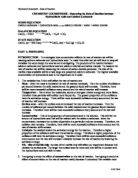Rate of Reaction between Calcium Carbonate and Hydrochloric acid
The Problem
To investigate how changing the concentration of acid effects the rate of reaction between calcium carbonate and hydrochloric acid.
Background Knowledge
Symbol equation
CaCO3 + 2 HCl --> CaCl2 + CO2 + H2O
Observations
* Fizzing and bubbling.
* The white solid disappears to give a colourless solution
* Container heats up
Rate of reaction
Rate of reaction is the speed at which a reaction occurs, it can be found by recording the amount of reactants used up or the amount of product formed in a given time.
For example in the reaction between hydrochloric acid and sodium thiosulphate a fine yellow precipitate of sulphur is produced. The rate of reaction can be measured as follows.
. A cross is marked on a piece of paper.
2. A beaker with a volume of sodium thiosulpate is placed on the cross.
3. Dilute hydrochloric acid is added and a stopwatch is started and the time taken for the cross to be no longer visible from above.
Over time the cross begins to fade.
For the reaction in this investigation there are a few ways of measuring the rate of reaction. The mass of the reacting mixture would decrease so it could be measured at intervals. But the best way to record the rate of reaction is to measure the amount of carbon dioxide given off using either a syringe or inverted burette underwater.
The Problem
To investigate how changing the concentration of acid effects the rate of reaction between calcium carbonate and hydrochloric acid.
Background Knowledge
Symbol equation
CaCO3 + 2 HCl --> CaCl2 + CO2 + H2O
Observations
* Fizzing and bubbling.
* The white solid disappears to give a colourless solution
* Container heats up
Rate of reaction
Rate of reaction is the speed at which a reaction occurs, it can be found by recording the amount of reactants used up or the amount of product formed in a given time.
For example in the reaction between hydrochloric acid and sodium thiosulphate a fine yellow precipitate of sulphur is produced. The rate of reaction can be measured as follows.
. A cross is marked on a piece of paper.
2. A beaker with a volume of sodium thiosulpate is placed on the cross.
3. Dilute hydrochloric acid is added and a stopwatch is started and the time taken for the cross to be no longer visible from above.
Over time the cross begins to fade.
For the reaction in this investigation there are a few ways of measuring the rate of reaction. The mass of the reacting mixture would decrease so it could be measured at intervals. But the best way to record the rate of reaction is to measure the amount of carbon dioxide given off using either a syringe or inverted burette underwater.







